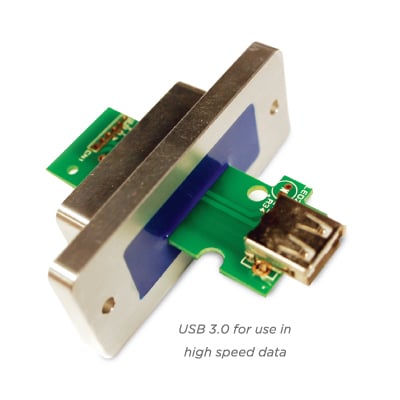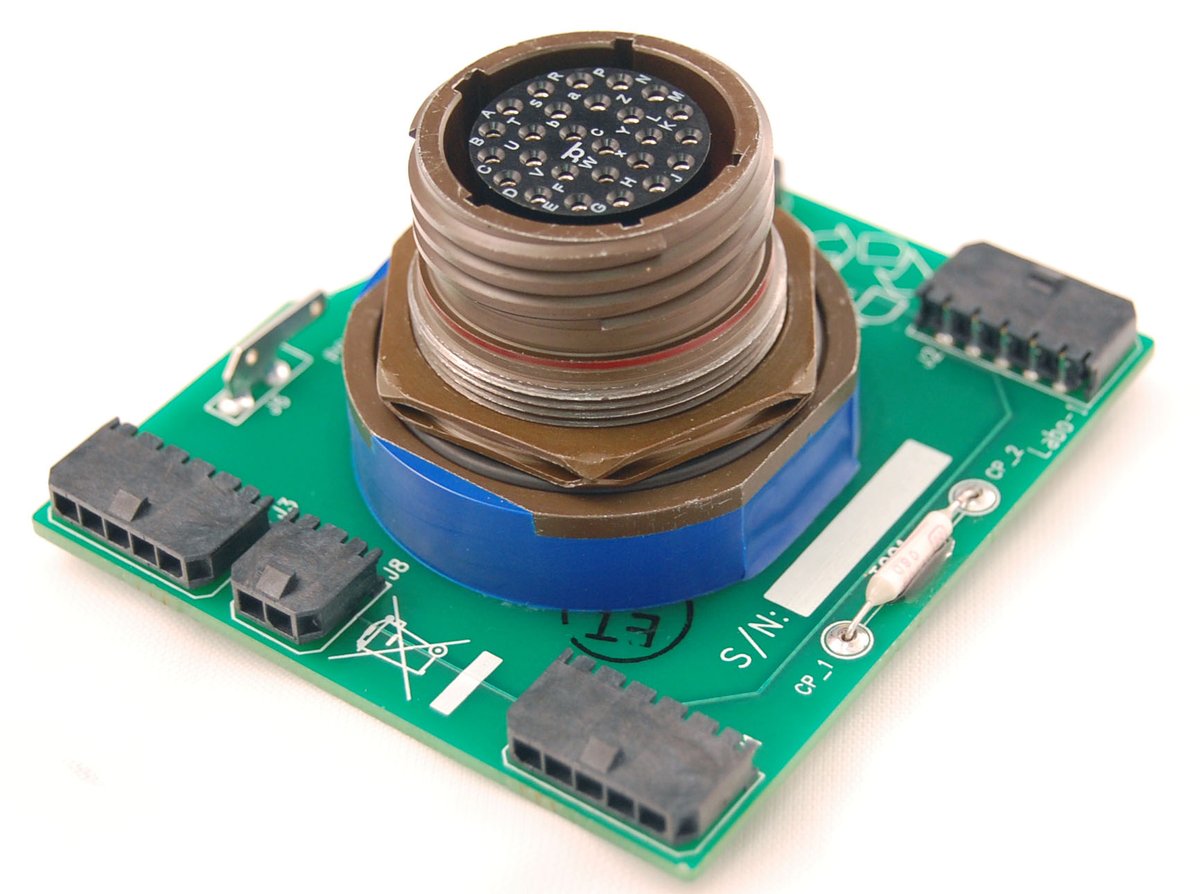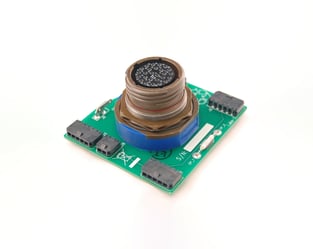What is CircuitSeal?
If you design underground electrical equipment or sealed devices, you increasingly have to tackle three related engineering problems. Not only do you have to improve the performance of your electrical systems, but you also have to reduce their size and cost. One technology that can help with all three problems is CircuitSeal. In the following white paper, we’ll take a deeper dive into CircuitSeal’s technical capabilities and offer up some design tips that you can easily apply to your
electrical assemblies.
Using our proven epoxy formulations, CircuitSeal creates direct hermetic seals around flex, rigid, and
hybrid circuit boards, as well as off-the-shelf flat flex cables (FFC). The technology also allows you to
incorporate passive electrical components into the sealed circuit assembly—such as filters, fuses and
resistors. And CircuitSeal complements our other epoxy-based hermetic sealing methods. For instance, you can combine CircuitSeal with back-potted connectors, or you can design hybrid hermetic seals that directly seal around both circuit boards and wires or other conductors.
Whenever you need your electrical systems to function reliably in pressurized, vacuum, moisture-prone or other kinds of harsh environments, CircuitSeal can play a role. Typical applications include:
- Semiconductor manufacturing equipment
- Instrumentation and control systems
- Automotive control and sensing systems
- Magnetic bearings systems, including compressors, turbo expanders, flywheels and turbines
- Environmental and vacuum chambers, including thermovac, vacuum heat treat and HAST systems
- Military weapon and transport systems
- Sealed-off laser systems
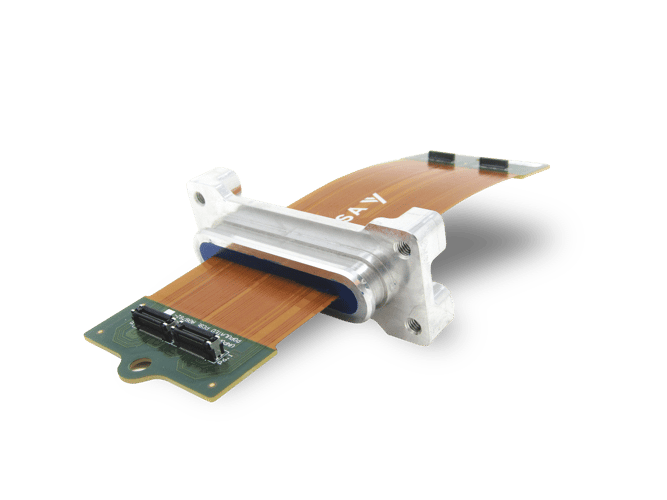
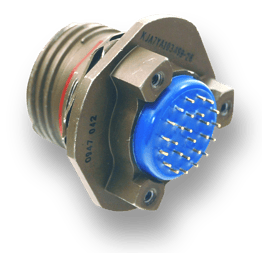
Compared to traditional feedthroughs and connectorized wire harnesses, which are still more widespread, CircuitSeal offers some significant advantages.
CircuitSeal Advantages
Improved performance. With signal conductors running directly to the circuit board, CircuitSeal helps maintain signal integrity while eliminating any losses or electrical noise (EMI) related to electrical connection points. Directly sealing the circuit board also does away with potential failure points at unnecessary electrical connections.
Compact size. CircuitSeal doesn’t just remove the need for bulky connectors; it also saves space
by facilitating high conductor densities and the integration of electrical components into one sealed
assembly. Depending on the application requirements, CircuitSeal assemblies are typically 30 to 70% smaller than comparable connector or wire based solutions
Enhanced protection from outgassing. A variety of sensors, switches, diodes and capacitors are
increasingly being potted in epoxy as part of the CircuitSeal process. Potting and hermetically
sealing these passive components effectively blocks contamination in vacuum systems due to outgassing, which benefits semiconductor, vacuum and space simulation applications.
Cost reduction. By integrating some components, eliminating others and sealing many conductors
in a single sealing operation, CircuitSeal dramatically reduces direct labor and overall costs. The amount of the savings varies but generally increases with conductor count and production volumes. For example, we’ve produced CircuitSeal assemblies with high conductor counts that cost 80% less than an equivalent connectorized wire harness.
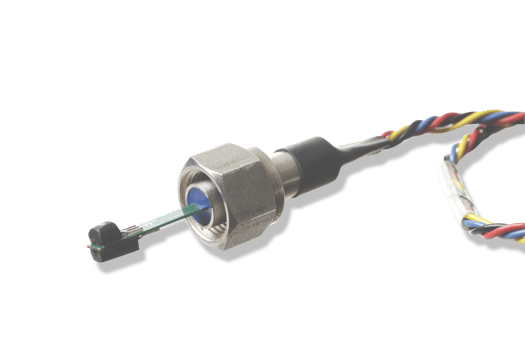
Incorporating Sensing Elements into Sealed Electrical Assemblies
One defining characteristic of CircuitSeal technology is its design flexibility. Not only can CircuitSeal work with many different types of circuit boards, but it can also integrate related electrical components to create a fully-functional, hermetically sealed electronics assembly. One such component is a sensing element. CircuitSeal assemblies routinely incorporate a sensing and signal conditioning elements of one type or another. Using epoxy, we can directly seal around pressure, temperature, humidity, proximity and other types of sensors in addition to capacitors, resistors,
switches and other signal conditioning components. A complete CircuitSeal sensing assembly would also include a circuit board, wire harness and a fitting or housing.
Sensor Assembly Advantages
Improved reliability. In harsh environments, sensor assemblies can have a very short working life.
CircuitSeal can protect the sensing electronics from moisture, chemicals, excess pressure, thermal
expansion, shock and vibration. CircuitSeal’s sealing performance is fully hermetic, with leak rates below 1 x 10-8 cc-He/sec at pressures exceeding 2,000 psi.
Reduced size, better fit, less weight. CircuitSeal sensing assemblies are compact. They allow creative packaging of the sensing element and its circuit board to save space. In one recent assembly, for example, we packaged a humidity sensor and a long, thin circuit into a small threaded fitting. Ultimately this creative solution reduced required components, assembly time Not only can CircuitSeal work with many different types of circuit boards, but it can also integrate related electrical components, such as humidity and oil level sensors (above). and cost for our customer while providing a proven long-term solution. In general, CircuitSeal sensing assemblies are typically at least 30% smaller than conventional wire and cable sealed sensing assemblies. However, as conductor count increases, so will space savings.
Lower cost. In production volumes, CircuitSeal sensing assemblies also cost less to produce, install and replace than sensing assemblies with a separate wire feedthrough. By integrating sensing, signal conditioning and hermetics into a single package, it reduces component count and overall system cost. Although figures can vary, it’s not uncommon to reduce costs by 50% or more in sensor
applications.
Minimized connection points. By integrating signal conditioning and sensing into the hermetic feedthrough, customers have seen an overall reduction in required cable harnesses which can further reduce complexity, cost and size. Some applications for sealed circuit assemblies involve
the use of a sensing element in vacuum or pressure chambers of one kind or another. Many CircuitSeal sensing assemblies have historically gone to work in space simulation equipment, but applications continue to expand with frequent use in military, automotive and electrical distribution applications. Increasingly, though, these sensing assemblies are also finding a home in vacuum applications where signal conditioning elements prone to outgassing need to be sealed inside epoxy to protect costly semiconductor wafers from contamination.
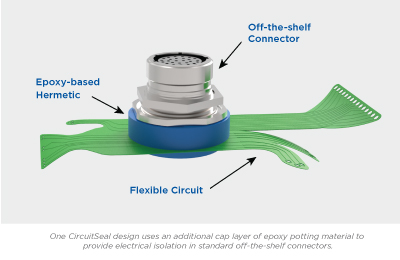
CircuitSeal for Signal
Another design variant of CircuitSeal involves using it with standard off-the-shelf connectors that don’t provide a hermetic seal. By using the epoxy to back-pot them, CircuitSeal can be combined with other electrical components, such as electrical circuits—achieving true hermetic performance.
The design uses an additional cap layer of epoxy potting material to provide electrical isolation. These hermetic back-potting operations are becoming more common, as we often need to work with off-the-shelf connectors that don’t provide a hermetic seal. By back-potting these standard connectors, however, we can take advantage of the low cost and design flexibility of these connectors without sacrificing hermetic performance
High conductor density, low cost
One of the biggest benefits to designing with CircuitSeal is the ability to achieve very high conductor density at a low cost. In one application involving a piece of laser equipment, we used CircuitSeal technology to create an epoxy hermetic seal directly to a piece of off-the-shelf flat flex cable (FFC). This approach allowed us to pack 52 conductors into a 0.25 x 0.25 x 0.5-inch space. Had we used a conventional wire feedthrough, the same number of conductors would have occupied a
1-inch diameter. This same job also highlights the cost saving potential of CircuitSeal. Taking
the cost of both materials and labor into account, the CircuitSeal and flat flex cable cost less than 2% of what a conventional wire feedthrough would cost.

Sealing High Frequency Precision Equipment
Coaxial solutions are increasingly being utilized at higher frequencies as part of glovebox, space simulation testing, and other vacuum applications. However, the process for sealing these cables and connectors is very labor-intensive and difficult to repeat with precision. CircuitSeal overcomes these challenges—enabling us to achieve high frequencies going beyond 40 Gigahertz.
Traditionally, when making a wire seal for high-frequency coaxial cabling, you must break the cable—including the outer jacket, shield and inner dielectric. Afterwards, you then have to reconstruct the cable while hermetically sealing it. Putting the cable back together the way it was originally manufactured is extremely difficult. To further complicate matters, the hermetic sealing epoxy has a different impedance and capacitance than the wire’s dielectric material. This means each coaxial cable requires a different geometry and production process for our manufacturing group, making tooling and process controls critical to performance at the higher frequencies.
CircuitSeal eliminates the need to completely deconstruct the cable or connector in order to seal it. Instead, the epoxy bonds the PCB to the inner diameter of the bulkhead housing, creating a direct hermetic seal around the circuit boards and wires. It should be noted that the CircuitSeal not only works for high frequency coaxial cable but also works for high data rate cables like HDMI, USB 3.0, Quadrax and other less common electrical protocols.
After substantial R&D on high-frequency coaxial cabling, we have found that our CircuitSeal technology enables us to achieve even higher frequencies than traditional sealing processes—going beyond 40 Gigahertz versus 10 Gigahertz. This is because PCBs can be designed to operate at high frequencies or high data rates with relative
ease. Such high-precision equipment is typically used in space simulation, including satellite testing and other data acquisition systems.
